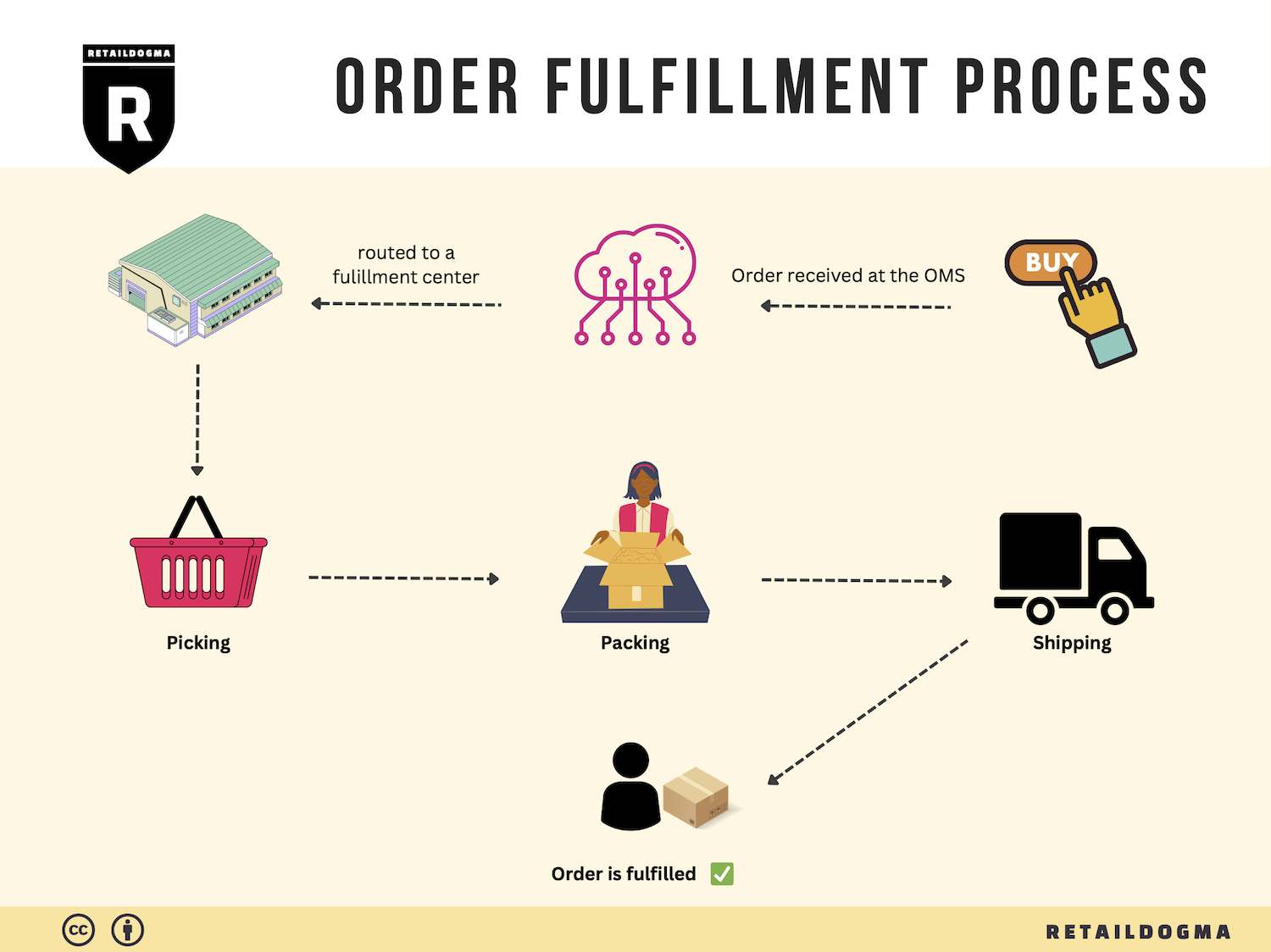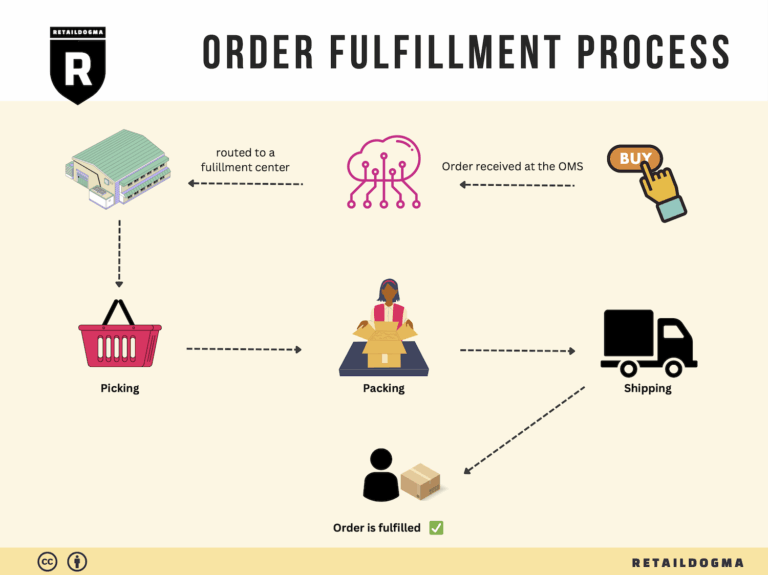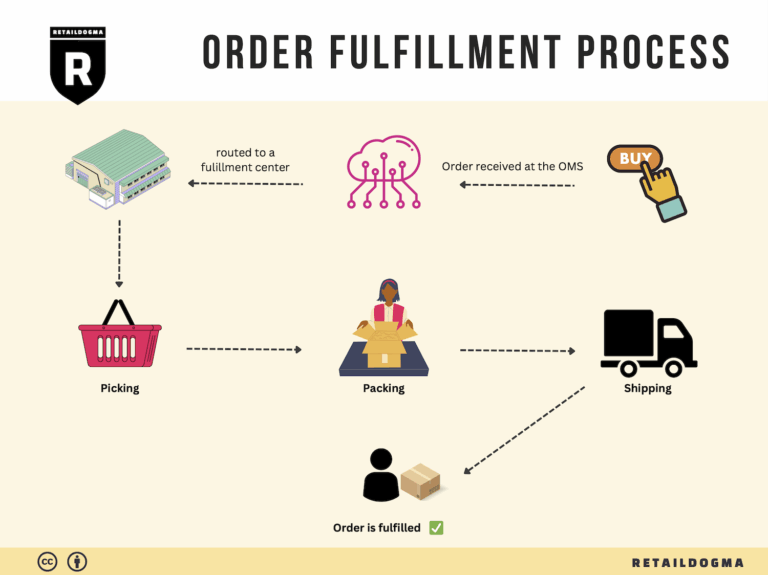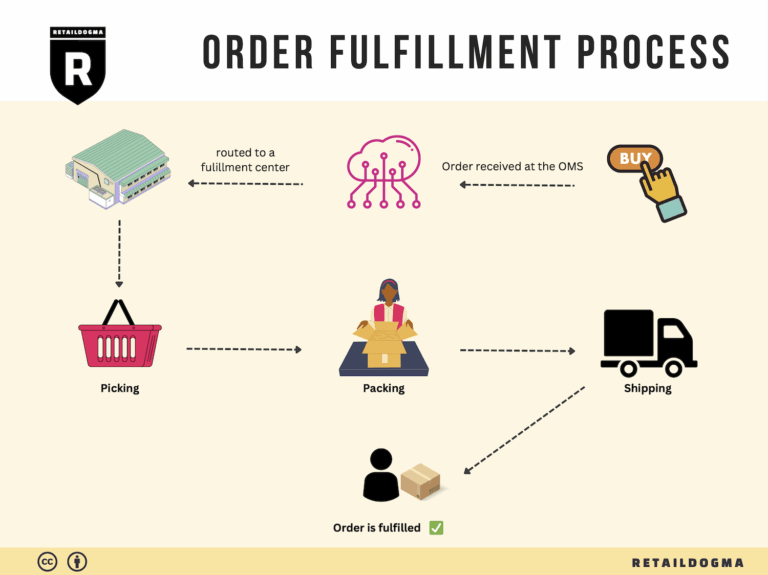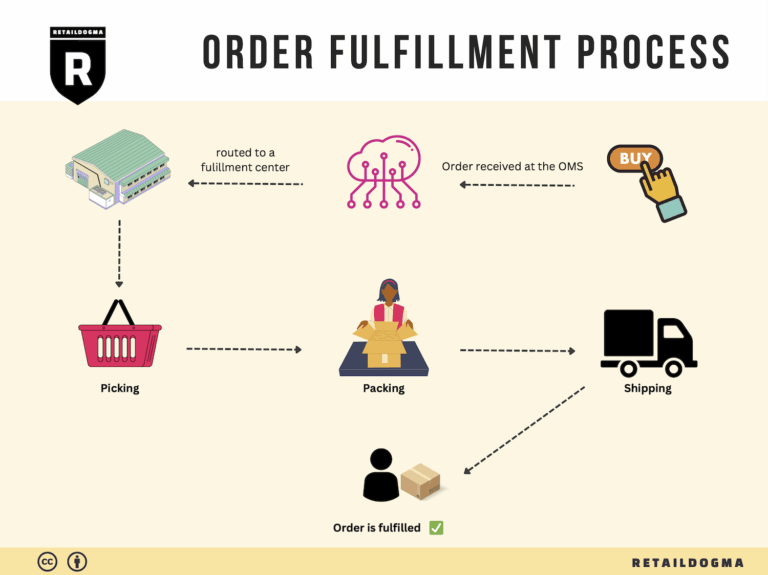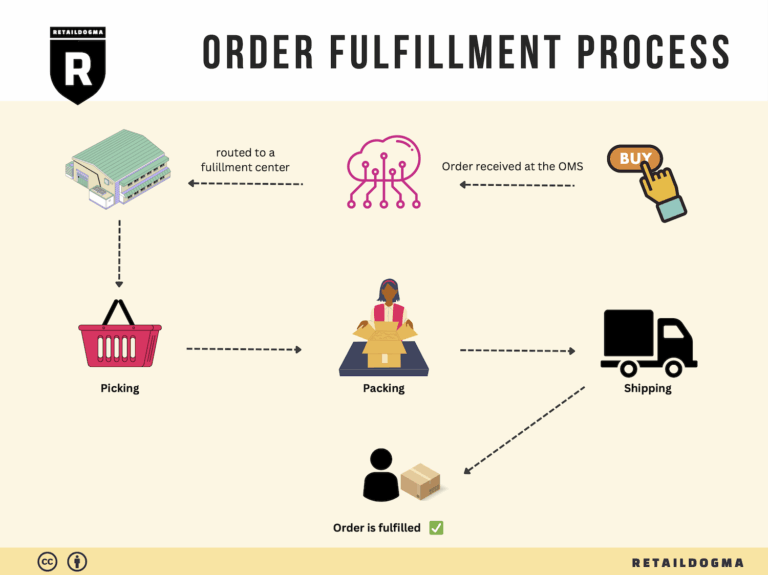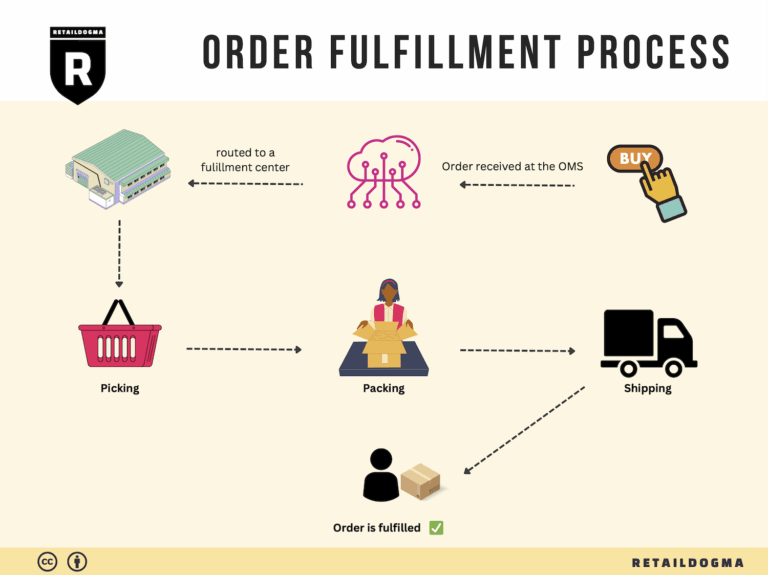Ecommerce Fulfillment Services: The Ultimate Guide (2025)
What is E-commerce Fulfillment? An Introduction for Growing Businesses
Navigating the Challenges of Order Fulfillment
As an e-commerce business owner, you may find yourself overwhelmed by the complexities of packing and shipping orders. The excitement of growing your sales can quickly turn into stress when you realize that managing logistics can consume your time and resources, detracting from your core business activities. Efficient order fulfillment is essential; it’s the backbone of your operations and a key driver of customer satisfaction. Essentially, fulfillment is the process of getting a product from your warehouse to your customer’s doorstep.
Understanding e-commerce fulfillment is crucial for any growing business. This guide aims to demystify the fulfillment process, covering various models available to you, such as Third-Party Logistics (3PL) and Fulfillment by Amazon (FBA). These models each offer unique advantages and can significantly impact your operational efficiency and customer experience.
We will delve into the core services involved in fulfillment, which include receiving inventory, warehousing, picking and packing orders, shipping, and managing returns. Each step plays a vital role in ensuring that your customers receive their products promptly and in excellent condition. By optimizing these processes, you can enhance your brand’s reputation and foster customer loyalty.
Choosing the right fulfillment partner is another critical decision that can determine the scalability and profitability of your business. This guide will provide insights into what to look for in a fulfillment partner, including their technological capabilities, geographic location, and customer service standards.
Furthermore, we will discuss pricing models associated with various fulfillment options. Understanding the costs involved is essential for budgeting and ensuring that your logistics remain profitable as you grow.
The goal of this guide is to empower you with the knowledge to make informed decisions about your logistics strategy. By understanding the intricacies of e-commerce fulfillment, you can streamline your operations, reduce overhead costs, and ultimately focus on what matters most—growing your business and delighting your customers.
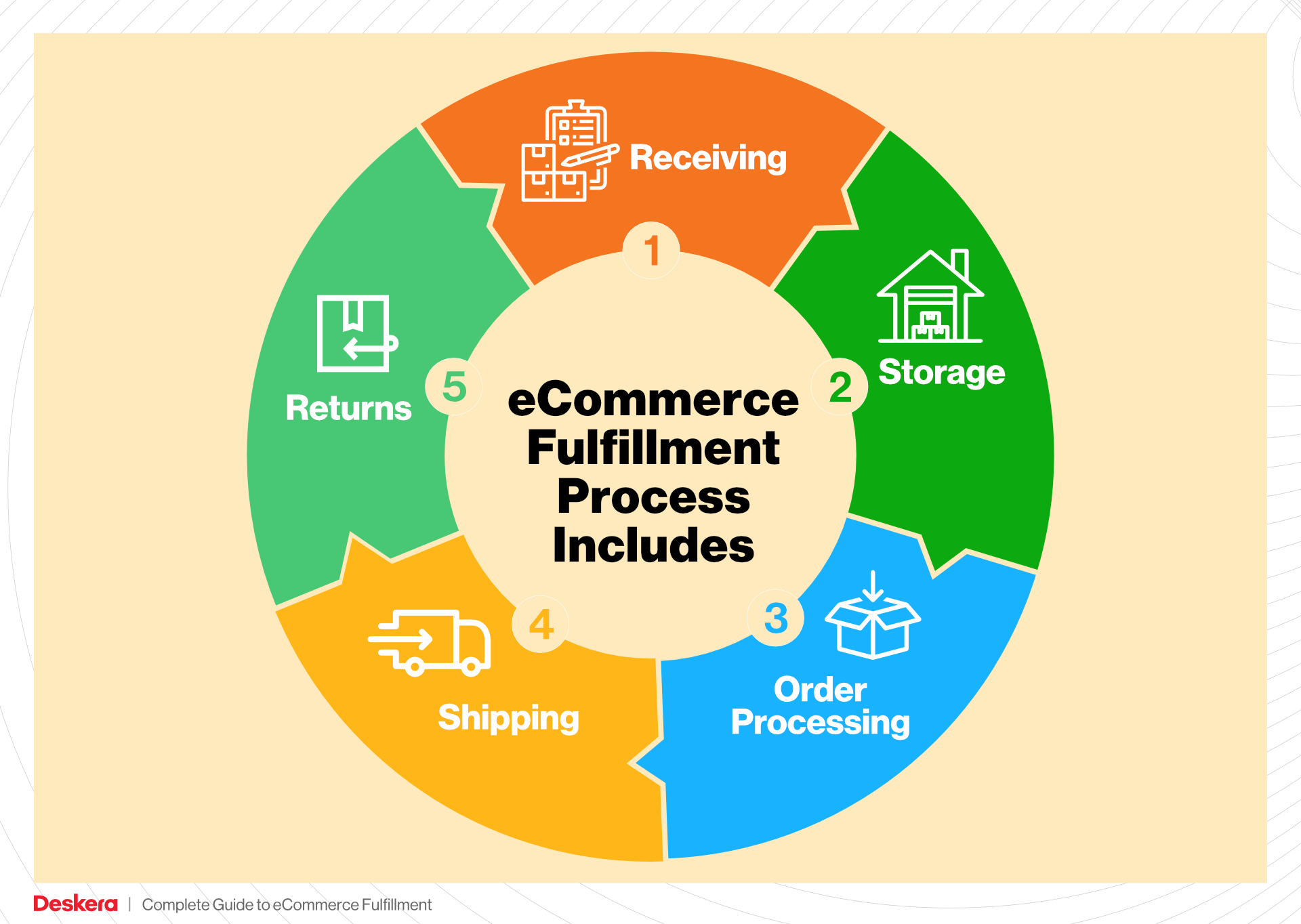
What You’ll Learn In This Guide
- What is E-commerce Fulfillment? An Introduction for Growing Businesses
- The Order Fulfillment Process: From ‘Buy’ Button to Customer’s Door
- Comparing Fulfillment Models: In-House vs. 3PL vs. Dropshipping
- A Deep Dive into Amazon FBA: Pros, Cons, and Who It’s For
- Core Services Offered by Fulfillment Centers
- How to Choose a Fulfillment Partner: A 6-Point Checklist
- Understanding Fulfillment Pricing: A Breakdown of Common Fees
- Frequently Asked Questions (FAQs) about Fulfillment
- Conclusion: Is Outsourcing Fulfillment the Right Move for Your Business?
- Important Disclaimer
The Order Fulfillment Process: From ‘Buy’ Button to Customer’s Door
1. Receiving Inventory
The order fulfillment process begins with receiving inventory at the fulfillment center. This critical step involves the arrival of products shipped from suppliers or manufacturers. When goods arrive, warehouse staff must ensure that they match the advance shipping notice (ASN) provided by the supplier, which outlines what to expect in terms of quantities and types of products.
Importance: Effective receiving processes prevent inventory discrepancies and ensure that all items are logged into the warehouse management system (WMS) quickly. This is vital because delays in receiving can lead to stockouts and missed sales opportunities. Additionally, identifying damaged goods at this stage can save costs and maintain product quality for customers.
Key Term: ASN (Advance Shipping Notice) – A document that provides detailed information about a shipment, allowing the warehouse to prepare for receiving and processing the goods efficiently.
2. Warehouse Storage
Once the inventory is received and verified, the next step is proper warehouse storage. This process involves organizing products within the fulfillment center using a systematic approach that facilitates easy access and efficient retrieval. Warehouses often employ strategies such as zone picking or dynamic slotting to optimize space and enhance picking efficiency.
Importance: The organization of inventory directly impacts the speed and accuracy of order fulfillment. Efficient storage systems reduce the time it takes for pickers to locate items, minimizing labor costs and improving overall operational efficiency. An organized warehouse is essential for maintaining inventory accuracy and ensuring that products are stored securely.
Key Term: SKU (Stock Keeping Unit) – A unique identifier assigned to each product, allowing for precise tracking and management of inventory.

3. Order Picking
When a customer places an order, the WMS generates a pick list that guides warehouse staff in gathering the required items. This step is known as order picking, where pickers retrieve products from their designated locations in the warehouse. Depending on the size of the operation, picking can be done individually or through batch picking methods, where multiple orders are processed simultaneously.
Importance: Timely and accurate order picking is crucial for customer satisfaction. Delays or errors during this stage can lead to shipping mistakes, which may negatively impact the customer experience. By employing efficient picking methods and utilizing technology, businesses can streamline this process, ensuring that orders are fulfilled quickly and accurately.
Key Term: Pick List – A document generated by the WMS that outlines the items to be collected for each order, including their locations within the warehouse.
4. Order Packing
After items are picked, they are taken to the packing station, where they are prepared for shipment. This stage involves placing products in appropriate packaging, adding protective materials, sealing boxes, and applying shipping labels. The choice of packaging can vary based on the type of product, ensuring that it is secure for transit.
Importance: Proper packing is essential for preventing damage during shipping and ensuring that the order arrives in good condition. It also plays a role in branding; well-packaged orders can enhance customer perception and encourage repeat business. Efficiency in packing can significantly reduce order processing times, further enhancing the customer experience.
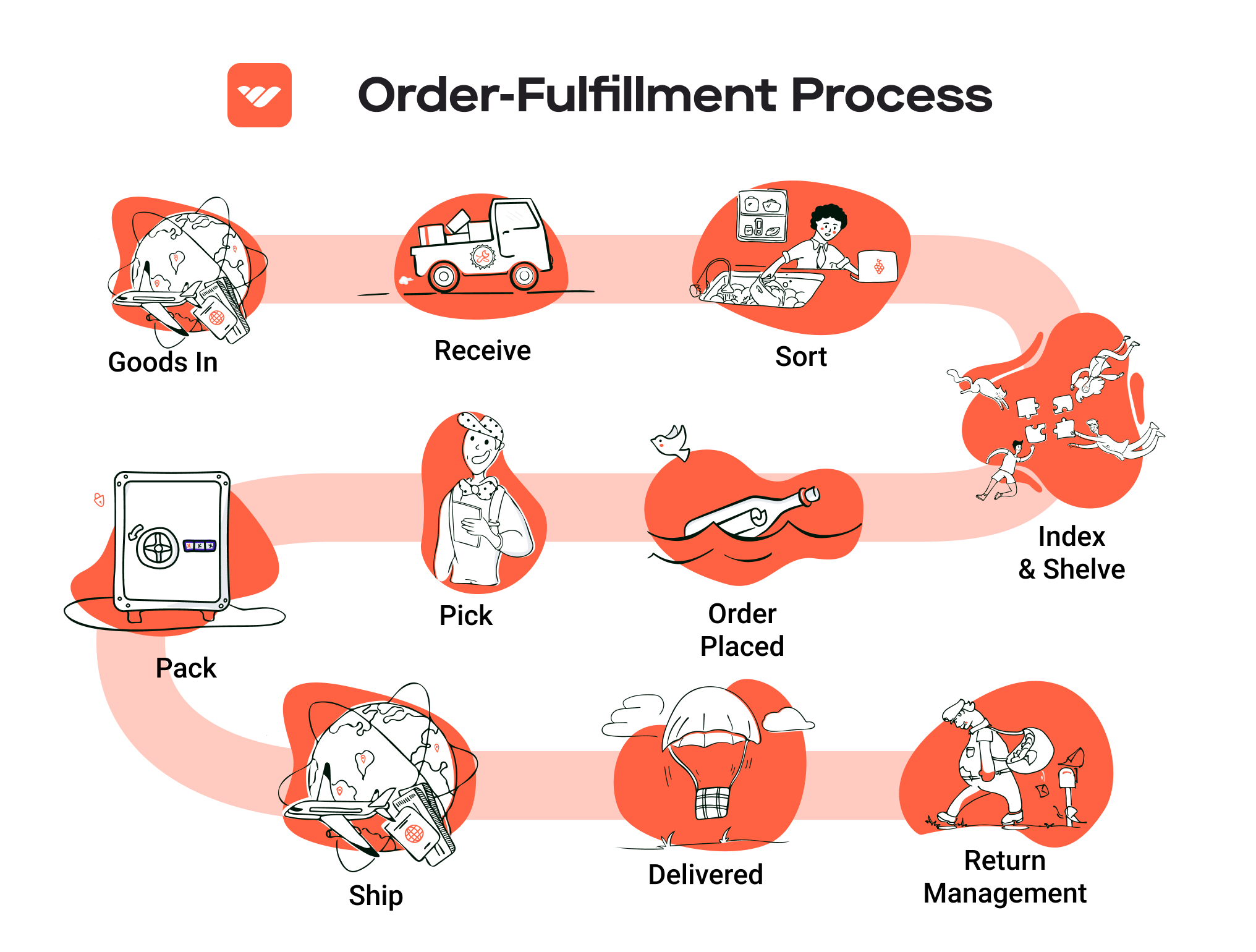
Key Term: Packing Slip – A document included in the package that lists the items included in the shipment, serving as a receipt for the customer.
5. Shipping & Delivery
The final step in the order fulfillment process is shipping and delivery. Once the package is packed and labeled, it is handed over to a carrier for delivery. Businesses often partner with multiple shipping carriers to offer various options to customers, such as standard, expedited, or same-day delivery. The choice of carrier can affect shipping costs, delivery times, and overall customer satisfaction.
Importance: Efficient shipping practices are vital for meeting customer expectations regarding delivery speed and reliability. A well-managed shipping process can differentiate a business in the competitive e-commerce landscape. Additionally, tracking capabilities should be integrated to keep customers informed about their order status, further enhancing transparency and trust.
Key Term: Last Mile Delivery – The final step in the shipping process where the package is delivered from a distribution center to the customer’s doorstep, often considered the most critical aspect of the logistics chain due to its impact on customer satisfaction.
In conclusion, understanding and optimizing each step of the order fulfillment process is crucial for e-commerce businesses looking to scale. Each phase, from receiving inventory to shipping and delivery, plays a significant role in customer satisfaction and operational efficiency. By focusing on these elements, businesses can create a seamless fulfillment experience that drives growth and loyalty.
Comparing Fulfillment Models: In-House vs. 3PL vs. Dropshipping
Fulfillment Model Comparison Table
| Model | Who Handles Inventory | Best For (Business Stage) | Key Advantage | Key Disadvantage |
|---|---|---|---|---|
| In-House Fulfillment | Business Owner/Staff | Startups to Mid-Sized Companies | Full control over inventory and processes | High overhead costs and labor intensity |
| Third-Party Logistics (3PL) | Third-Party Provider | Growing to Established Businesses | Scalability and reduced operational burden | Less control over inventory management |
| Dropshipping | Supplier/Vendor | New Businesses and Niche Markets | Low startup costs and no inventory risk | Lower profit margins and less control over fulfillment speed |
In-House Fulfillment
In-house fulfillment involves managing the entire order fulfillment process within your business. This means you handle everything from inventory management to packing and shipping orders. For startups and mid-sized companies, in-house fulfillment can provide a high level of control over the customer experience and inventory. You can customize packaging, manage shipping timelines, and directly oversee the quality of the process. However, the key downside is the substantial overhead costs associated with warehousing, staffing, and operational management. As your order volume increases, scaling in-house operations can become labor-intensive and financially burdensome, leading to potential inefficiencies and fulfillment delays.
Third-Party Logistics (3PL)
Third-party logistics (3PL) providers handle the logistics of fulfillment on behalf of businesses. Companies partner with 3PLs to manage warehousing, inventory management, order processing, and shipping. This model is ideal for growing to established businesses that want to focus on core competencies while outsourcing the complexities of logistics. The primary advantage of using a 3PL is the scalability it offers; businesses can easily adjust their fulfillment capabilities to meet changing demand without investing in additional infrastructure. However, a significant disadvantage is the potential loss of control over inventory management and fulfillment processes. Companies may face challenges in communication and coordination with their 3PL partner, which can lead to fulfillment errors or delays that impact customer satisfaction.
Dropshipping
Dropshipping is a fulfillment model where the retailer does not keep products in stock. Instead, when a customer places an order, the retailer purchases the item from a third-party supplier who ships it directly to the customer. This model is particularly well-suited for new businesses and niche markets, as it requires minimal upfront investment and eliminates the risk of holding unsold inventory. The primary advantage of dropshipping is its low startup cost and operational simplicity, allowing entrepreneurs to focus on marketing and customer acquisition rather than logistics. However, dropshipping has notable drawbacks, including lower profit margins due to reliance on suppliers and less control over shipping times and product quality. This can result in longer delivery times and customer dissatisfaction if the supplier fails to meet expected service levels.
Conclusion
Selecting the right fulfillment model is critical to the success of your e-commerce business. Each model—whether in-house fulfillment, third-party logistics, or dropshipping—has its unique advantages and disadvantages. As you evaluate these options, consider your business’s current stage, growth ambitions, and operational capabilities. By aligning your fulfillment strategy with your overall business goals, you can effectively enhance customer satisfaction and drive sustainable growth.
A Deep Dive into Amazon FBA: Pros, Cons, and Who It’s For
Understanding Fulfillment by Amazon (FBA)
Fulfillment by Amazon (FBA) is a service provided by Amazon that allows sellers to store their products in Amazon’s fulfillment centers. Amazon then takes care of storage, packaging, shipping, and customer service for those products. This system enables sellers to leverage Amazon’s vast logistics network, ensuring that their products reach customers quickly and efficiently.
How FBA Works
-
Setting Up: Sellers start by creating an Amazon Seller account and enrolling in FBA. They can then send their products to Amazon’s fulfillment centers, where items will be stored until sold.
-
Storage: Once products arrive at the fulfillment center, they are scanned and stored. Amazon manages the inventory, providing sellers with real-time data on stock levels.
-
Order Processing: When a customer places an order, Amazon picks, packs, and ships the product directly to the customer. This process is typically very fast, often resulting in same-day or next-day delivery.
-
Customer Service: Amazon also handles all customer inquiries and returns, allowing sellers to focus on other aspects of their business.
-
Multi-Channel Fulfillment: Sellers can use FBA not just for their Amazon sales, but also for orders from other platforms, such as their own websites. This capability allows for a streamlined logistics process across multiple sales channels.
Pros of Amazon FBA
1. Prime Eligibility
Products fulfilled by Amazon are eligible for Amazon Prime, a subscription service that offers free two-day shipping to members. This can significantly increase sales, as Prime members tend to prefer Prime-eligible products.
2. Customer Trust
Amazon is a well-established brand known for its reliability. By using FBA, sellers can benefit from Amazon’s reputation, which can enhance customer trust and encourage more purchases.
3. Multi-Channel Fulfillment
FBA allows sellers to fulfill orders from other platforms using Amazon’s logistics network. This flexibility can simplify operations and reduce the need for multiple fulfillment solutions.
4. Scalability
FBA is designed to help sellers scale their businesses without the need for significant investments in infrastructure. As sales grow, sellers can easily send more inventory to Amazon’s warehouses.
5. Reduced Workload
By outsourcing fulfillment, sellers can focus on other critical areas of their business, such as marketing, product development, and customer engagement.
Cons of Amazon FBA
1. High Fees
While FBA can simplify logistics, it can also be costly. Sellers face various fees, including storage fees for inventory and fulfillment fees based on the size and weight of products. These costs can quickly add up, impacting profit margins.
2. Strict Inventory Rules
Amazon has strict guidelines regarding inventory management, including limits on how much inventory can be stored based on sales performance. Sellers may face penalties for excess inventory, which can lead to additional fees or even inventory removal.
3. Commingling Risks
FBA has a commingling policy where products from different sellers are stored together. This can lead to issues if a customer receives a product that is defective or not as described. If a seller’s product is mixed with others, it can be challenging to trace back to the source, potentially harming the seller’s reputation.
4. Limited Control
Sellers have limited control over the fulfillment process once their products are in Amazon’s hands. This can be frustrating, especially if there are issues with inventory management or shipping delays.
5. Dependence on Amazon
Using FBA can create a dependency on Amazon’s platform. If policies change or if there are fluctuations in sales, sellers may find themselves vulnerable to Amazon’s decisions.
Who is FBA Best For?
FBA can be a great option for a variety of sellers, but it is particularly beneficial for:
-
Small to Medium-Sized Businesses: Companies looking to scale without investing heavily in logistics infrastructure can benefit from the efficiencies FBA offers.
-
E-commerce Entrepreneurs: New sellers who may not have the resources or knowledge to manage fulfillment logistics can leverage FBA to simplify operations and focus on growth.
-
Brands with High Sales Volume: Businesses that have a steady flow of sales can better absorb FBA fees, making the service more cost-effective.
-
Sellers Seeking Prime Access: Brands that want to tap into the vast Prime customer base will find FBA essential for increasing visibility and sales.
-
Multi-Channel Sellers: Those who sell on multiple platforms can streamline their operations by using FBA for all order fulfillment needs.
In conclusion, while FBA offers significant advantages such as Prime eligibility, customer trust, and operational efficiency, it is essential for sellers to carefully consider the associated costs and limitations. By understanding both the pros and cons, e-commerce business owners can make an informed decision about whether FBA aligns with their growth strategy and operational needs.
Core Services Offered by Fulfillment Centers
Inventory Management & Warehousing
Inventory management is the backbone of any successful e-commerce operation, and fulfillment centers excel in this area. They provide sophisticated warehousing solutions that include receiving, storing, and tracking inventory levels in real-time. Fulfillment centers use advanced Warehouse Management Systems (WMS) to efficiently manage stock, ensuring that products are stored in organized layouts, which reduces retrieval times.
The benefits of robust inventory management include:
-
Optimized Stock Levels: By analyzing sales data and trends, fulfillment centers help e-commerce businesses maintain optimal stock levels, minimizing the risk of overstocking or stockouts. This ensures that products are available when customers want them, enhancing customer satisfaction.
-
Real-Time Tracking: Many fulfillment centers offer real-time inventory tracking, allowing e-commerce businesses to monitor stock levels, sales trends, and reorder points. This transparency helps in making informed purchasing decisions and managing cash flow effectively.
-
Reduced Overhead Costs: Outsourcing warehousing to a fulfillment center eliminates the need for businesses to invest in their own storage facilities, reducing overhead costs associated with rent, utilities, and staffing.
Pick and Pack Services
Pick and pack services are crucial for fulfilling customer orders accurately and efficiently. When a customer places an order, fulfillment centers utilize their WMS to generate a pick list, allowing warehouse staff to quickly locate and gather the required items. Once picked, the items are packed into boxes, labeled, and prepared for shipment.
The advantages of effective pick and pack services include:
-
Speedy Order Fulfillment: Fulfillment centers are designed for high efficiency, allowing businesses to process orders faster. Quick turnaround times can significantly enhance customer satisfaction and encourage repeat purchases.
-
Accuracy: Automated systems reduce the likelihood of human errors during the picking and packing process. This accuracy minimizes returns due to incorrect shipments, which can be costly and damaging to a brand’s reputation.
-
Scalability: As e-commerce businesses grow, their order volumes can fluctuate dramatically. Fulfillment centers provide scalable pick and pack services that can easily adjust to varying order quantities, ensuring that businesses can meet customer demand without being overburdened during peak times.
Kitting and Assembly
Kitting and assembly services involve the grouping of multiple products into a single package or preparing items for sale as a complete unit. This is particularly beneficial for businesses that offer bundles, subscription boxes, or require assembly of products before shipping.
The benefits of kitting and assembly services include:
-
Enhanced Customer Experience: By offering bundled products or pre-assembled items, e-commerce businesses can provide customers with a more streamlined shopping experience. This not only saves customers time but can also lead to increased sales through upselling and cross-selling strategies.
-
Cost Efficiency: Outsourcing kitting and assembly to fulfillment centers can reduce labor costs and the complexity of managing these processes in-house. Fulfillment centers often have specialized equipment and trained personnel to handle these tasks more efficiently.
-
Inventory Control: Kitting services can help businesses manage inventory more effectively by consolidating multiple SKUs into single packaged units, simplifying inventory management and reducing the number of individual items tracked.
Returns Management (Reverse Logistics)
Returns management, or reverse logistics, is an essential service provided by fulfillment centers. Given the high return rates typical in e-commerce, especially in sectors like fashion and electronics, having an efficient returns process is critical for maintaining customer trust and satisfaction.
The benefits of effective returns management include:
-
Streamlined Returns Processing: Fulfillment centers handle returns quickly, inspecting items upon arrival and determining their resale condition. This efficiency reduces the time that products spend out of inventory, allowing businesses to recoup costs faster.
-
Customer Satisfaction: A smooth and hassle-free returns process enhances the overall shopping experience. Fulfillment centers can manage returns directly, providing customers with easy return options and timely refunds, which fosters loyalty and repeat business.
-
Data Insights: Returns management can also provide valuable insights into customer behavior and product performance. By analyzing return reasons, e-commerce businesses can make informed decisions about product quality, marketing strategies, and inventory management.
In conclusion, partnering with a fulfillment center can significantly enhance an e-commerce business’s operational efficiency, customer satisfaction, and overall growth potential. By leveraging the core services offered—inventory management and warehousing, pick and pack services, kitting and assembly, and returns management—businesses can focus on scaling their sales while leaving the logistics to experts.
How to Choose a Fulfillment Partner: A 6-Point Checklist
Location & Warehouse Network
Importance:
The geographical location of your fulfillment partner’s warehouses can significantly impact shipping times and costs. A strategically located fulfillment center allows for quicker delivery to your customers, which is essential for maintaining high levels of customer satisfaction.
Questions to Ask:
– Where are your warehouses located, and how many do you operate?
– Can you provide shipping times to my primary customer regions?
– Do you have a plan for expanding your warehouse network if my business grows?
Technology & Integrations
Importance:
In today’s fast-paced e-commerce environment, having a robust technology stack is crucial. Your fulfillment partner should offer a Warehouse Management System (WMS) that integrates seamlessly with your e-commerce platform. This integration allows for real-time inventory updates, order processing, and tracking, ultimately improving operational efficiency.
Questions to Ask:
– What technology platform do you use for order management and inventory tracking?
– Can your system integrate with my existing e-commerce platform (e.g., Shopify, WooCommerce)?
– How do you handle inventory accuracy and updates in real-time?
Specializations (e.g., Cold Storage, Oversized Items)
Importance:
Depending on your product types, you may require a fulfillment partner that specializes in certain areas such as cold storage for perishable goods or handling oversized items. Choosing a partner that can accommodate your specific needs can save costs and reduce the risk of fulfillment errors.
Questions to Ask:
– Do you have specialized facilities for specific product types (e.g., food, electronics, large items)?
– What processes do you have in place to handle products that require special conditions (e.g., temperature control)?
– How do you manage inventory for seasonal or fluctuating demand items?
Scalability & Capacity
Importance:
As your business grows, your fulfillment needs will change. A partner that can scale with you—whether through additional warehouse space, staff, or technological capabilities—ensures that you won’t face service disruptions as your order volume increases.
Questions to Ask:
– How do you handle increased order volume during peak seasons?
– What is your capacity for scaling operations, and how quickly can you adapt?
– Can you share examples of how you’ve supported other clients during their growth phases?
Pricing and Contracts
Importance:
Understanding the pricing structure and contract terms is vital to avoid unexpected costs that can eat into your profits. A transparent pricing model helps you budget effectively and ensures you know what you’re paying for.
Questions to Ask:
– What is your pricing model (e.g., per order, per item, monthly fees)?
– Are there any hidden fees I should be aware of (e.g., storage, returns)?
– What are the terms of the contract, and is there flexibility for adjustments as my business evolves?
Customer Support & Reviews
Importance:
Effective customer support is essential for resolving issues quickly and maintaining a smooth operation. Additionally, checking reviews and testimonials can provide insight into the reliability and service quality of a fulfillment partner.
Questions to Ask:
– What customer support channels do you offer (e.g., phone, email, chat)?
– What are your response times for inquiries and issues?
– Can you provide references or case studies from current or past clients?
Conclusion
Choosing the right fulfillment partner is a critical decision for any e-commerce business. By using this checklist, you can ensure that you evaluate potential partners comprehensively, focusing on factors that will directly impact your operational efficiency and customer satisfaction. A strategic partnership in fulfillment can drive growth, enhance customer experience, and ultimately contribute to the long-term success of your business.
Understanding Fulfillment Pricing: A Breakdown of Common Fees
Initial Setup Fees
Initial setup fees are typically incurred when you first engage a fulfillment center. These fees cover the costs associated with onboarding your business, which may include integrating your e-commerce platform with the fulfillment provider’s system, setting up your inventory in their warehouse management system (WMS), and any necessary training for your staff.
The calculation of initial setup fees can vary significantly among providers, often depending on the complexity of your business and the level of customization required. For instance, a straightforward integration with a standard e-commerce platform may incur lower fees than a more intricate setup involving multiple sales channels. It’s crucial to clarify what is included in these fees—some providers may charge for additional services like custom packaging or advanced reporting features.
Receiving Fees
Receiving fees are charged for the process of accepting your inventory into the fulfillment center. This fee is assessed based on the volume of products being received and can vary based on factors such as the size and weight of the items.
Typically, fulfillment centers charge a per-unit fee for each item received, or they may have a flat fee for a specific quantity of items. Some providers also charge for additional services, such as inspecting goods for damage, sorting items, or labeling products. To keep costs manageable, it’s advisable to provide advance shipping notices (ASNs) to streamline the receiving process and potentially avoid extra charges for delays or inefficiencies.
Storage Fees (per pallet/bin)
Storage fees are incurred for the space your products occupy in the warehouse. These fees are usually calculated on a per-pallet or per-bin basis, depending on how your items are stored. A pallet typically holds larger quantities of goods, while bins are used for smaller items.
Storage fees can be charged monthly or based on a daily rate, and the cost will vary depending on the size of the items stored and the overall volume of inventory. For example, bulky items may incur higher storage fees than smaller, easily stackable products. To optimize storage costs, consider strategies like just-in-time inventory management, which can help minimize the amount of time your products spend in storage.
Pick & Pack Fees (per item/order)
Pick and pack fees are charged for the labor involved in retrieving items from storage and preparing them for shipment. These fees can be calculated either per item or per order, with some fulfillment centers offering tiered pricing based on order volume.
For instance, a fulfillment center may charge a flat fee for picking and packing a single order, plus an additional fee for each item included in that order. Understanding how these fees are structured is essential for budgeting, especially if your business experiences fluctuations in order volume. To mitigate costs, consider optimizing your product offerings to streamline the picking process, or discussing volume discounts with your fulfillment provider.
Shipping Fees
Shipping fees encompass the costs associated with delivering your orders to customers. These fees can vary widely based on factors such as the shipping method selected (standard, expedited, etc.), the weight and dimensions of the package, and the distance to the delivery location.
Most fulfillment centers partner with multiple carriers, which allows you to choose the shipping options that best align with your budget and customer service goals. Shipping fees may be calculated based on a combination of flat rates, weight-based pricing, and dimensional weight pricing. It’s advisable to compare different carriers and shipping methods to find the most cost-effective solution for your specific needs.
Tips for Getting an Accurate Quote
-
Provide Detailed Information: When requesting quotes from fulfillment providers, be as detailed as possible about your products, order volume, and specific fulfillment needs. This includes dimensions, weight, and any special handling requirements.
-
Ask About Hidden Fees: Inquire about any potential hidden fees that may not be included in the initial quote, such as additional charges for returns, storage of oversized items, or seasonal volume fluctuations.
-
Consider Long-Term Needs: Think about how your business may scale in the future. Discuss potential growth with your provider and ask how their pricing structure can accommodate increasing order volumes or additional services.
-
Request a Breakdown of Costs: Ask for a detailed breakdown of all fees associated with fulfillment services. This will help you understand the cost structure and identify areas where you can potentially negotiate or reduce expenses.
By taking these steps, you can ensure a more accurate and comprehensive understanding of fulfillment pricing, allowing you to make informed decisions as you scale your e-commerce business.
Frequently Asked Questions (FAQs) about Fulfillment
1. What is the fulfillment process in e-commerce?
The fulfillment process in e-commerce encompasses all activities involved in receiving, processing, and delivering customer orders. It begins with the receipt of inventory at a fulfillment center, followed by storage, order picking, packing, shipping, and returns management. Each step is critical to ensuring timely and accurate delivery to customers, ultimately impacting their satisfaction and your business’s reputation.
2. What’s the difference between a warehouse and a fulfillment center?
A warehouse is primarily a storage facility for goods, while a fulfillment center is designed for order processing and shipping. Fulfillment centers not only store products but also manage inventory, pick and pack orders, and handle returns. Essentially, all fulfillment centers are warehouses, but not all warehouses function as fulfillment centers.
3. What is a 3PL?
A 3PL, or third-party logistics provider, is a company that offers logistics services, including warehousing, fulfillment, and shipping, on behalf of another business. By partnering with a 3PL, e-commerce businesses can scale operations without the need to invest in their own infrastructure, allowing them to focus on core activities like marketing and product development.
4. How much do fulfillment services cost?
The cost of fulfillment services varies widely based on several factors, including the volume of orders, the type of products, storage space requirements, and shipping methods. Generally, costs may include storage fees (charged per pallet or cubic foot), picking and packing fees (per order), and shipping costs (based on weight and destination). It’s essential to obtain quotes from multiple providers to find a solution that fits your budget and needs.
5. How do I choose the right fulfillment partner?
When selecting a fulfillment partner, consider factors such as their location (proximity to your customer base), technology integration capabilities (ease of connecting with your e-commerce platform), service offerings (returns processing, international shipping), and reputation (reviews from other clients). It’s also beneficial to evaluate their scalability to accommodate your business growth.
6. What technologies are used in the fulfillment process?
The fulfillment process relies on various technologies, including Warehouse Management Systems (WMS) for inventory tracking, Order Management Systems (OMS) for processing orders, and shipping software to manage logistics. Automation tools, such as barcode scanners and conveyor systems, can also enhance efficiency and accuracy in picking and packing operations.
7. How can I improve my fulfillment efficiency?
To enhance fulfillment efficiency, consider implementing a robust WMS, optimizing your warehouse layout for faster picking, training staff on best practices, and utilizing automation where possible. Regularly reviewing your processes and seeking feedback from your team can also help identify areas for improvement.
8. What is the role of inventory management in fulfillment?
Inventory management is crucial in fulfillment as it ensures that the right products are available to meet customer demand without overstocking. Effective inventory management minimizes storage costs and reduces the risk of stockouts, which can lead to lost sales. Utilizing technology for real-time inventory tracking can greatly enhance accuracy and efficiency.
9. How do I handle returns in the fulfillment process?
Handling returns effectively involves establishing a clear returns policy and process. You can either manage returns in-house or through your fulfillment partner. Key steps include inspecting returned items, restocking sellable products, and processing refunds or exchanges promptly. A streamlined returns process not only improves customer satisfaction but also helps recapture value from returned products.
10. What are common challenges in the fulfillment process?
Common challenges in the fulfillment process include managing inventory levels, ensuring timely deliveries, handling returns efficiently, and maintaining accurate order processing. Additionally, fluctuating demand can complicate inventory management. To address these challenges, businesses should focus on data analytics for forecasting, invest in technology, and continually refine their fulfillment strategies.
Conclusion: Is Outsourcing Fulfillment the Right Move for Your Business?
Evaluating the Benefits of Outsourcing Fulfillment
Outsourcing fulfillment can be a transformative decision for e-commerce businesses aiming for growth. By leveraging a third-party fulfillment service, you can save significant time and resources. This allows you to focus on core business activities such as product development, marketing, and customer engagement, rather than getting bogged down in the complexities of order logistics.
One of the primary advantages of outsourcing is scalability. As your business grows, so too do your fulfillment needs. A fulfillment partner can seamlessly accommodate fluctuations in order volume, whether you’re ramping up for a seasonal surge or expanding into new markets. This flexibility is crucial for maintaining customer satisfaction, as timely and accurate delivery remains a critical component of the e-commerce experience.
Additionally, fulfillment services bring a level of expertise that is difficult to replicate in-house. These providers have advanced warehouse management systems, established shipping relationships, and a wealth of experience in managing logistics efficiently. This expertise can significantly reduce fulfillment errors and enhance your overall operational efficiency, ultimately leading to better customer retention and increased revenue.
However, the success of outsourcing fulfillment hinges on selecting the right partner. Look for a provider that aligns with your business goals, has a proven track record, and offers transparent communication and reliable performance metrics. A thorough vetting process can help ensure that your chosen partner can support your growth trajectory.
Take Action Now
As you evaluate the potential benefits of outsourcing fulfillment, consider conducting a comprehensive audit of your current shipping processes. Identify pain points, inefficiencies, and areas for improvement. This assessment will help you determine if partnering with a fulfillment service is the next strategic step toward scaling your e-commerce business effectively.
Important Disclaimer
⚠️ Important Disclaimer
The information in this guide is for educational purposes. Fulfillment services, pricing, and platform features change frequently. Always conduct your own due diligence and consult with providers directly before making business decisions.
